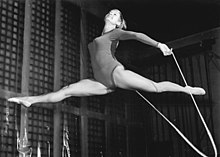Handheld device
The hand tools used in rhythmic gymnastics are rope, hoop, ball, clubs and ribbon.
The devices pose different challenges to their users. The ribbon, for example, can easily become knotted, the ball roll away or the clubs fall out of your hand. Each individual exercise is carried out with one of the handheld devices; for group exercises , two or a maximum of three devices can be used. Among other things, it is assessed how well the gymnast can handle the device.
ball
- material
- Rubber or synthetic material (on condition that this material has the same elasticity as rubber)
- diameter
- 18 to 20 centimeters
- Weight
- At least 400 grams
- colour
- free choice, since 1997 the colors gold and silver are also allowed; Balls with large figurative drawings will not be accepted; only geometric drawings are allowed
- handling
- the ball is the only handheld device that does not allow a grip; this means that a soulful relationship between the body and the device is required; the ball moves in perfect harmony with the body, spectacular throws with controlled and precise catches are dynamic elements
tape
- material
- Satin or other similar materials; not strengthened
- width
- four to six centimeters
- length
- at least six meters; this part must consist of a single piece, the end with which the tape is attached to the rod can be doubled over a maximum length of one meter; At the upper end, a very thin reinforcement of a maximum of five centimeters can be pushed between the two strap parts
- Weight
- at least 35 grams, without rod and attachment
- colour
- free choice; since 1997 the colors gold and silver have also been allowed
Rod
- material
- Wood, plastic or fiberglass
- diameter
- a maximum of one centimeter at the thickest point
- length
- 50 to 60 centimeters, including fastening ring
- shape
- cylindrical, conical or a combination of the two shapes; the lower end can be wrapped with adhesive tape or a non-slip material over a length of a maximum of ten centimeters
- colour
- free choice; since 1997 the colors gold and silver have also been allowed
Attachment
- material
- any suitable material
- length
- Without a fastening ring at the top of the rod, a maximum of seven centimeters
- handling
- the ribbon is long and light and can be thrown in all directions; Its purpose is to draw figures in space, its flights through the air create images and forms of all kinds; many figures of different sizes are executed in variable rhythms: snakes, spirals and throws are essential for the flight of the ribbon
Clubs
- material
- Wood or plastic
- length
- 40 to 50 centimeters
- Weight
- 150 grams
- Diameter of the club head
- three centimeters maximum
- shape
- bottle-like, consisting of the three parts “body” (bulbous part), “neck” (slender part) and “head” (spherical part; this can be replaced by widening the outermost neck end); the three parts can be wrapped with adhesive tape or a non-slip material, provided that the diameter of the head is not more than three centimeters
- colour
- natural or colored (in whole or in part) with one or more colors; the clubs can be of different colors; since 1997 the colors gold and silver have been allowed
- handling
- the gymnast uses the clubs to perform mills, rolls, spins, throws, and as many asymmetrical figures as possible, combined with the many figures of gymnastics without hand tools; Clubs are particularly suitable for two-handed gymnasts.
tires
- material
- Wood or plastic (on condition that the material does not deform during movement)
- diameter
- 80 to 90 centimeters inside diameter
- Weight
- At least 300 grams
- shape
- round; the tire can be smooth or roughened and completely or partially wrapped with an adhesive tape of the same color or a different color
- colour
- natural color or colored (completely or partially) with one or more colors, since 1997 the colors gold and silver have also been allowed
- handling
- the tire defines a space; this is mainly occupied by the gymnast, who moves within the formed circle; Handling the tire requires frequent changes of grip and, most importantly, good coordination of movement, the shape of the tire prefers rolling, passages, rotations and other games
rope
- material
- Hemp, cotton or synthetic material (on condition that this material has the same lightness and mobility as hemp ropes)
- length
- proportional to the size of the gymnast
- end up
- no handles, just a knot or two on each end
- shape
- constant diameter or becoming thicker towards the middle part (provided that the thickening is made of the same material as the rope)
- colour
- Natural or colored (in whole or in part), since 1997 the colors gold and silver have also been allowed
- handling
- the technical figures can be performed either with the rope taut or loose, with one or both hands, with or without changing hands; the relationship between the device and the gymnast is more explosive than with the other devices, the rope often appears as a snake-like attacker that grabs and wraps the gymnast, but softness and agility, coupled with elegance, always prevail in the end
literature
- Sibylle Gienger: Rhythmic gymnastics . Rowohlt, Reinbek 1988, ISBN 978-3-499-18610-3 .
- TS Lissizkaja (ed.): Rhythmic gymnastics . Sportverlag, Berlin 1985, ISBN 978-3-328-00119-5 .
- Hildegard Wendt, Ruth Hess: Artistic gymnastics with hand devices . 4th edition. Sportverlag, Berlin 1979, DNB 800133366 .




